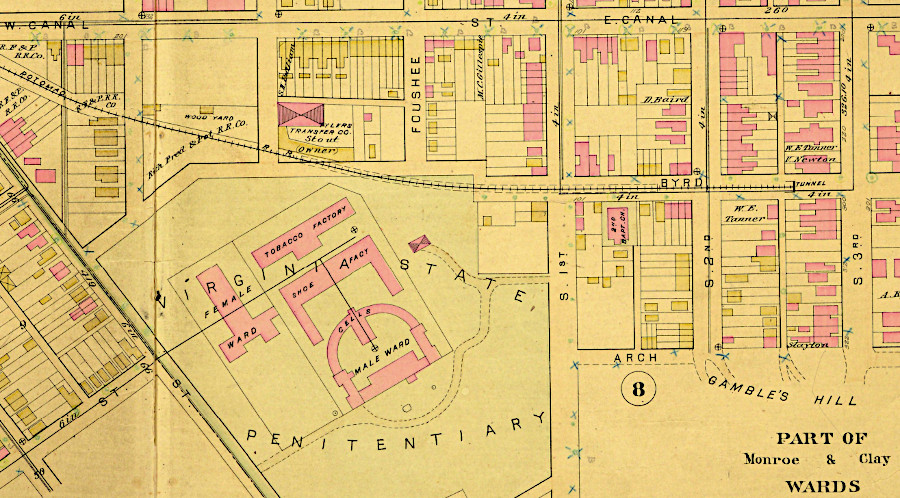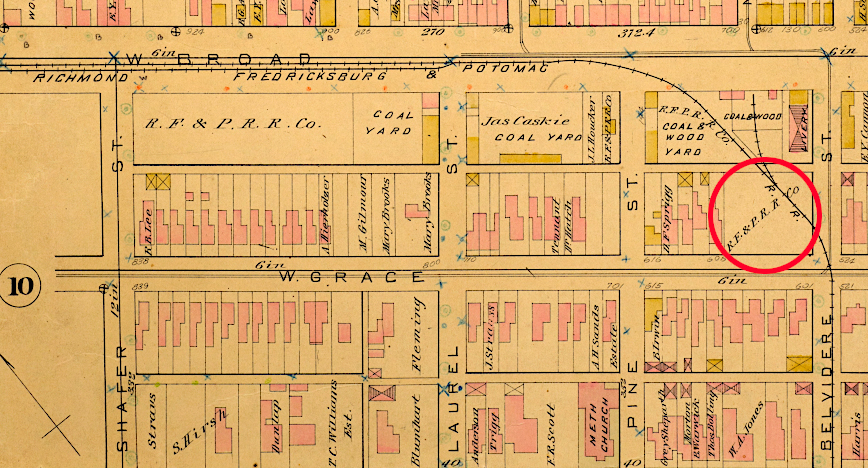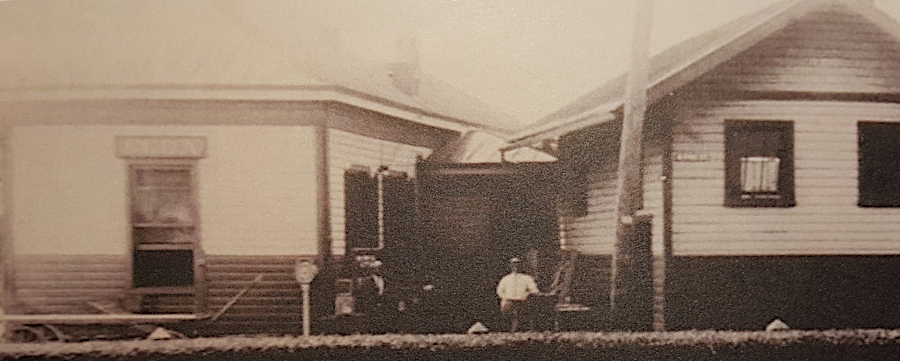
the Richmond, Fredericksburg and Potomac and the Richmond and Petersburg Connection Railroad included a tunnel on Byrd Street
Source: Virginia Commonwealth University, Baist Atlas of Richmond - Outline & index map Richmond and vicinity (1899)

the Richmond, Fredericksburg and Potomac and the Richmond and Petersburg Connection Railroad included a tunnel on Byrd Street
Source: Virginia Commonwealth University, Baist Atlas of Richmond - Outline & index map Richmond and vicinity (1899)
The Richmond, Fredericksburg and Potomac (RF&P) Railroad built north from Richmond in 1834. At the southern end, it built shops, headquarters, and a passenger/freight station at 8th and Broad ("H") streets. That site is now between the National Theater and the Library of Virginia.1
The Richmond and Petersburg Railroad built a bridge across the James River and opened its Byrd Street station in Richmond, next to the James River and Kanawha Canal, in 1838. That site is currently occupied by the Federal Reserve Bank.2
Between 1838-1861, passengers going between Petersburg-Fredericksburg had to walk or take a stage for six blocks between the separate railroad stations. Freight going between Petersburg and Fredericksburg was transported between the two train depots by teamsters using wagons.
The two railroads, owned by different stockholders, did not see enough economic opportunity to justify building a link up the hill from the James River to Broad Street. City officials supported inefficient transfers of freight and passengers, because it stimulated economic activity within Richmond. The jobs associated with slow, horse-drawn transfers between terminals would disappear if trains could pass through Richmond directly.
Military necessity during the Civil War drove the General Assembly to authorize a connection, and for city officials to authorize it. By August, 1861, track was constructed up 8th Street to connect the Richmond and Petersburg depot on Byrd Street to the Richmond, Fredericksburg and Potomac Railroad on Broad Street.3
Both the Richmond and Petersburg Railroad bridge over the James River and the depot in Richmond were destroyed by the Evacuation Fire in April,1865. Traditional political arrangements were disrupted by post-war Reconstruction, as investors sought to rebuild. The General Assembly prioritized economic recovery, and was more accommodating to northern investors willing to finance railroad development. The two railroads decided to partner and construct a connection.
In 1866 the legislature issued a charter for the Richmond, Fredericksburg and Potomac and Richmond and Petersburg Connection Railroad, with 1.5 miles of track and the "the country’s shortest railroad with the longest name."
The Richmond, Fredericksburg and Potomac Railroad (RF&P) leased the new railroad together with the Richmond and Petersburg Railroad; the connecting line was not an independent company. The two railroads shared revenues equally, but the Richmond, Fredericksburg and Potomac Railroad was responsible for 78.5% of the costs.4
The new Richmond, Fredericksburg and Potomac and Richmond and Petersburg Connection Railroad track opened in 1867. It did not go straight up 8th Street; that hill was too steep. Instead, the new track ran west of the Richmond and Petersburg Railroad's passenger and freight station at Eighth and Canal streets, through a tunnel dug starting at Second Street. It went underneath Third Street and Fourth Street, emerging at Fifth streets. The tunnel cut through Gamble's Hill adjacent to the State Penitentiary. Today the Downtown Expressway occupies that space.5


the Connection Railroad cut a tunnel through Gambles Hill, next to the State Penitentiary
Source: Virginia Commonwealth University (VCU), State Penitentiary, Richmond, Va.; Source: Virginia Commonwealth University (VCU), Baist Atlas of Richmond, VA (1889)
At Belvedere Street, the Richmond, Fredericksburg and Potomac and Richmond and Petersburg Connection Railroad track turned north to a connection with the Richmond, Fredericksburg and Potomac Railroad on Broad Street. Because the track did not go up Eighth Street, the connection was not at the existing Richmond, Fredericksburg and Potomac Railroad depot. Instead, a new depot was constructed at Broad and Pine streets, where the Institute for Contemporary Art of Virginia Commonwealth University (VCU) is now located.

the Richmond, Fredericksburg and Potomac and Richmond and Petersburg Connection Railroad linked up with the Richmond, Fredericksburg and Potomac Railroad at the Elba station
Source: Virginia Commonwealth University (VCU), Baist Atlas of Richmond, VA (1889)
The junction was known as "Elba" When a mansion house had been built there, the site was considered to be so far from downtown that it was equivalent to the island where Napoleon was exiled in 1814. Locals referred to it as the "Elbow" station. The Richmond, Fredericksburg and Potomac Railroad rebuilt the Elba depot in 1879, after city officials forced the Richmond, Fredericksburg and Potomac Railroad to comply with an ordinance banning the use of locomotives on Broad Street near its previous depot.6
In 1885-1887, the two railroads combined to build a new passenger station, Byrd Station, next to the Richmond and Petersburg Railroad's depot. The Elba station was no longer used for passengers.

the Elba station opened in 1867, was rebuilt in 1879, and was replaced by Byrd Station for passenger travel in 1887
Source: Virginia Commonwealth University (VCU)

two railroads used Byrd Station for passengers between 1887-1919
Source: Virginia Commonwealth University (VCU), Byrd Street (Union) Depot, Richmond, Va (1889)

in 1887 the Richmond, Fredericksburg and Potomac (RF&P) and the Richmond and Petersburg railroads opened the Byrd Street Station
Source: Virginia Commonwealth University (VCU), Baist Atlas of Richmond, VA - Part of Madison & Monroe Wards Richmond (1889)
The two railroads combined to build a bypass to carry freight trains around the west side of Richmond, speeding the north-flow delivery of freight. The new Belt Line, with a bridge across the James River, was completed in 1891. The bypass eliminated the need to use the Richmond, Fredericksburg and Potomac and the Richmond and Petersburg Connection Railroad (the "Connection Railroad") for freight traffic. Passenger trains continued to use the Connection Railroad depots at Byrd Station and Elba.

the first Belt Line bridge over the James River lasted from 1881-1916
Source: Virginia Commonwealth University (VCU), View of James River showing Belt Line Bridge, Richmond, Va (1908)
In 1898, the Richmond and Petersburg Railroad became part of the Atlantic Coast Line of Virginia, and then the Atlantic Coast Line in 1900. In 1913, the Atlantic Coast Line and the Richmond, Fredericksburg and Potomac Railroad announced that John Russell Pope would design a new "union" station, to be located on the Fair Grounds. The RF&P had purchased that property in 1904 for speculative real estate development, but had not built anything yet.
A new passenger station was needed in part because neither Byrd Station nor Elba Station had tracks long enough to accommodate long passenger trains. Trains had to be shortened to get through Richmond because locomotives could pull just a few cars up the grade from the James River to Broad Street. Using the freight bypass for passengers trains would eliminate the need for the Connection Railroad tracks, and eliminate complaints from city residents about trains blocking traffic in town - but required building a new passenger station.
Construction of Broad Street Station started in 1917. World War I intervened, and it took two years and additional funding to finish the project. The old stations had to handle the surge of passenger traffic during World War I. Broad Street Station finally opened in 1919.7
When passenger trains started using Broad Street station, there was no longer any need for the Connection Railroad. The rails were pulled up, and today the Downtown Expressway covers the route once used by trains west of Byrd Street Station. The tunnel was filled in during the Great Depression, thanks to a Works Progress Administration grant. The station remained the Atlantic Coast Line headquarters office until 1958.8

the Elba depot is now the site of a modern art museum in Richmond
Source: Virginia Commonwealth University (VCU), Institute for Contemporary Art